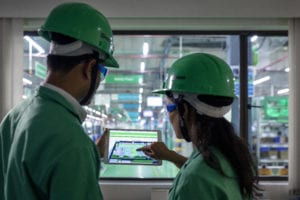In episode 5 of the EcoXpert Podcast – Enabling Buildings of the Future, I virtually reconnect with Chris Böttger from Cisco interviewed in one of our earlier episodes on How Will IoT Affect the WorkSpace of the Future, to talk about what has happened in the last 9 months with the global pandemic of COVID-19 and how this is already affecting the design, usage and performance expectations of buildings. Chris, who works on Americas Workplace Experience Strategy for Webex Devices, gives fascinating insight into how system collaboration and user experience will play a key role in the health and safety of employees in the future.
Since the start of the global pandemic, things have been changing far quicker than we had originally thought back in episode 2. Chris and I previously discussed the typical issue of not having enough building space and managing it efficiently, however the issue has become quite literally the opposite for building owners as there is now lots of space and not enough people to populate it due to social distancing mandates.
Webex Room Systems has made it possible to fill a building up responsibly while still following local COVID-19 guidelines through instant room counts driving real time user behavior rather than concentrating on what has already happened in the room. This feature gives comfort to users as they are not held responsible for being fully aware of continuously changing social distancing policies. Using location analytics for insights into the behavior of how people are interacting in physical spaces, Cisco DNA Spaces can be used to efficiently count the people outside and inside any given room. When there’s too many people in a space, users receive an automated audible message to alert them in real time.

Ensuring safety in the workplace during a global pandemic
Workplace apps and platforms are being programmed to show spaces available to work while remaining socially distanced. It would be very difficult to solely rely on an app on a users’ phone to give a notification, so by combining with common area notification systems and screens, rules and codes can be quickly communicated and enforced. Chris describes how Webex Rooms and Digital Signage can help with this. These systems show the number of occupants in a crowd meter type of visual covering the social aspect of the room. The environmental piece of that is to come with the displayed heatmaps to illustrate the conditions of the room such as air quality, carbon dioxide levels, etc. important to the health of the occupants.
Air quality of buildings
People often fear that not enough fresh air in an office space will make them more susceptible to getting exposed to the virus. As seen in the airline industry, airplanes are recirculating much less air than before and are passing fresh air through the airplane cabin. We are seeing the same for office buildings. Chris explains that the building management systems can filter in more fresh air which not only keeps occupants attentive and engaged, it is also important to their health. However, this means more energy and costs for building owners. To counteract that, people counts should be considered in order to control the building based on the amount of people physically in each room.
Driving the change
The health of the building, individual, and overall environment has become a major challenge. I asked Chris who he thinks are the right people to approach for this. He believes Human Resources is the start to driving these changes in a building environment. HR is concerned with employee health and retainment. The goal is to make sure employees do not feel neglected, isolated, or unengaged and to avoid any disconnects while employees work from home. In fact, they already are starting to play a major role in these changes, linking to the way energy efficiency is maintained. Corporate real estate companies will start to implement, and it will then be very relevant for downstream players like facility managers. With all these technical systems coming together, system integrators such as EcoXpert business partners will be heavily relied on to integrate it all in an IoT connected way to provide services in real time.
We’re turning IoT into “HoT”, a made-up acronym to mean “Health of Things”. Maintaining a tight connection between people present in the building, the BMS, and how the building reacts to keep occupants safe and comfortable is a must. The objective is wellbeing.
Chis states that explosions of shared spaces will occur because of companies deliberately downsizing their space to focus on both at home and shared office space. Companies should aim to keep employees engaged with the same environmental and collaborative experience no matter where they physically are. The takeaway is that the global pandemic has accelerated smart buildings. The health and safety of people in the office and working from home will be the driver for the future of commercial buildings.
Listen to the full episode 5 to hear more about the changes the global pandemic has brought to the building environment! Search “EcoXpert” on any listening app to listen or download for free and subscribe to the channel to receive new episodes automatically.



